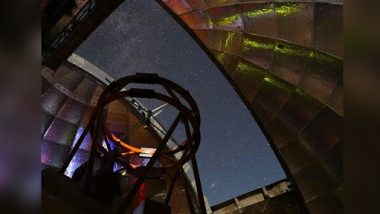Washington, March 21: The largest asteroid is predicted to pass by Earth this year on Sunday, March 21, giving astronomers a feast for the eyes! The massive asteroid called 2001 FO32, will make its closest approach at a distance of about 1.25 million miles (2 million kilometers) – or 5 1/4 times the distance from Earth to the Moon. According to the National Aeronautics and Space Administration (NASA), the largest asteroid will be at its closest on March 21, which will give astronomers a rare opportunity to get a good look at a rocky relic that formed at the dawn of our solar system.
2001 FO32 Asteroid Date and Time to Watch
The asteroid will be at its closest to Earth at around 1600 GMT on March 21, Sunday, according to the Paris Observatory, France's largest astronomy research centre. In India, astronomers can get a glimpse of 2001 FO32 asteroid passing the Earth at 9:30 pm Sunday, March 21. The asteroid will be the brightest while it moves through southern skies. There is no threat of a collision with our planet now or for centuries to come, NASA has said. The space agency said that the next time 2001 FO32 will be close to Earth will be 2052.
The 2001 FO32 asteroid, during this approach, will pass by at about 77,000 mph (124,000 kph) – faster than the speed at which most asteroids encounter Earth. The reason for the asteroid’s unusually speedy close approach is its highly inclined and elongated (or eccentric) orbit around the Sun, an orbit that is tilted 39 degrees to Earth’s orbital plane. This orbit takes the asteroid closer to the Sun than Mercury and twice as far from the Sun as Mars. Asteroid 2020 XU6, ‘Stadium-Sized’ Space Rock Is Approaching Towards Earth, Warns NASA; But There’s No Need to Start Doomsday Prep!
In an official release, NASA said that it knows the orbital path of 2001 FO32 around the Sun very accurately since it was discovered 20 years ago and there is no chance that it would get any closer to Earth and cause harm. "We know the orbital path of 2001 FO32 around the Sun very accurately since it was discovered 20 years ago and has been tracked ever since,” said Paul Chodas, director of the Center for Near-Earth Object Studies (CNEOS), which is managed by NASA’s Jet Propulsion Laboratory in Southern California.
“There is no chance the asteroid will get any closer to Earth than 1.25 million miles", NASA said. The 2001 FO32 asteroid has been designated a 'potentially hazardous asteroid' by NASA as that distance (1.25 million miles) is close in astronomical terms.
According to details by NASA, As 2001 FO32 makes its inner solar system journey, the asteroid picks up speed like a skateboarder rolling down a halfpipe, and then slows after being flung back out into deep space and swinging back toward the Sun. It completes one orbit every 810 days (about 2 1/4 years)
About 2001 FO32 Asteroid:
Asteroid 2001 FO32 was discovered in March 2001 by the Lincoln Near-Earth Asteroid Research (LINEAR) program in Socorro, New Mexico. Based on optical measurements, the asteroid had been estimated to be roughly 3,000 feet (1 kilometer) wide. In recent observations, 2001 FO32 appears to be faint when observed in infrared wavelengths, which suggests the object is likely less than 1 kilometer in diameter. Analysis by the NEOWISE team shows that it is between 1,300 to 2,230 feet (440 to 680 meters) wide.
(The above story first appeared on LatestLY on Mar 21, 2021 07:51 PM IST. For more news and updates on politics, world, sports, entertainment and lifestyle, log on to our website latestly.com).













 Quickly
Quickly











